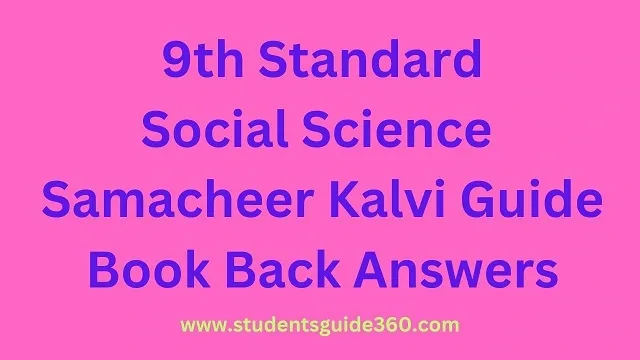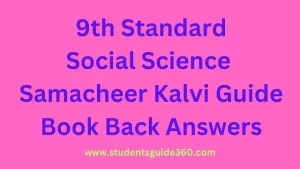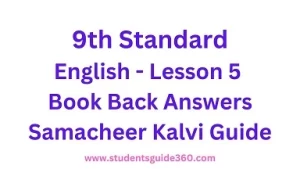9th Social Science (History) Lesson 7 Book Back Answers
9th Standard Social Science Unit 7 State and Society in Medieval IndiaBook Back Answers History Lesson 7 State and Society in Medieval India Book Back Answers English Medium. 9 All Subject Book Answers. Class 9 Social Science All Unit Book in Answers TM & EM.

9th Social Science (History) Lesson 7 Book Back Answers
I Choose the correct answer:-
1. …………… was the second stronghold of Ala-ud-din Khalji’s expanding Kingdom.
- Dauladabad
- Delhi
- Madurai
- Bidar
Ans :Dauladabad
2. The Deccan Sultanates were conquered by ……………
- Ala-ud-din Khilji
- Ala-ud-din Bahman- shah
- Aurangzeb
- Malik Kafur
Ans : Aurangzeb
3. The establishment of …………… empire changed the administrative and institutional structures of South India.
- Bahmani
- Vijayanagar
- Mughal
- Nayak
Ans: Vijayanagar
4. Krishnadeva Raya was a contemporary of ……………
- Babur
- Humayun
- Akbar
- Shershah
Ans: a) Babur
II Find out the correct statement
1. i) The establishment of the Vijayanagar Kingdom witnessed the most momentous development in the history of South India.
ii) The Saluva dynasty ruled for a longer period.
iii) The rulers of Vijayanagara had smooth relations with the Bahmani Sultanate.
iv) Rajput kingdoms attracted migrants from Persia and Arabia.
Ans: (i) is the correct statement
2. i) The Nayak Kingdom came up in Senji.
ii) The appointment of Telugu Nayaks resulted in the migration of Teluguspeaking people from Madurai.
iii) Mughal Empire started declining from the time of Jahangir.
iv) The Europeans came to India in search of slaves.
Ans: (i) is the correct statement
3. i) Mythical geneologies were collected by Col. Mackenzie.
ii) Indigo was the most important beverage crop in India.
iii) Mahmud Gawan was the minister in Alauddin Khalji’s kingdom.
iv) The Portuguese built their first fort in Goa.
Ans: (i) is the correct statement
4. Assertion (A) : India was an integral part of maritime trade, extending from China in the east to Africa in the west.
Reason (R) : Geographical location of India in the middle of Indian Ocean.
i) A is correct; R explains about A
ii) A is wrong; R is correct
iii) A and R are wrong
iv) A is correct; R does not explains about A.
Ans : a) i) A is correct; R explains about A
5. i) Gold images of great beauty and artistry were made by Cholas.
ii) The best example for Chola architecture is Siva as Nataraja performing the cosmic dance.
(i) is correct (ii) is wrong
Both (i) and (ii) is correct
Both (i) and (ii) are wrong
(i) is wrong, (ii) is correct
Ans : d) (i) is wrong, (ii) is correct
III. Fill in the blanks
1. ………….. were Europeans who arrived on the west coast of India.
Ans : Portuguese
2. The combined forces of the five Deccan Sultanates defeated Vijayanagar army in 1565 A.D. (C.E.) at the battle of …………..
Ans : Talikota
3. Vijayanagara evolved as a …………..
Ans : Militaristic state
4. The tempo of urbanization increased during ………….. period.
Ans : Vijayanagar
5. ………….. was the enterprising period in the history of Tamil Nadu.
Ans : The Chola period
IV. Match the following
1. Portuguese – Bengal
2. Tansen – Kottam
3. Sericulture – Court of Akbar
4. Angkorwat – Goa
5. District – Cambodia
Ans: 1 – D, 2 – C, 3 – A, 4 – E, 5 – B
V. Answer all questions given under each heading
1. The arrival of the Europeans :
a) Who controlled the spice trade from India?
Muslims.
b) What enabled the Portuguese to have control over maritime trade over the entire region.
Naval superiority.
c) How were the trading activities of the Europeans carried on in India?
Through the respective East India companies, Europeans carried on the trade in India.
d) Mention the enclaves of the Dutch, the English, the French and the Danes in India.
- Dutch – Policat (Later Nagapatnam)
- British – Madras (Chennai)
- French – Pondicherry (Puducherry)
- Danes – Tarangampadi (Tranquebar)
2. Society, Religion and culture:
a) Which is the most distinctive aspect of Indian Society?
Caste.
b) What is a guild?
Association of merchants and traders.
c) Mention some Saivite movements.
Saivasinddhanta, Virasaivas and Varkaisampradaya.
d) Name the court musician of Akbar.
Tansen.
VI Answer the following briefly
1. Write about the military expeditions of Malik Kafur.
- Malik Kafur was the commander and slave of Alauddin Khalji.
- In the first decade of the 1300s A.D, Malik Kafur was sent on military expedition to South.
- He captured Devagiri from the Yadavas at the end of 13th century.
2. Who founded the Vijayanagar kingdom? Mention the dynasties that ruled over the kingdom.
- The Vijayanagar kingdom was established by the two brothers, Harihara and Bukka.
- The three dynasties such as Sangama dynasty, Saluva dynasty and Tuluva dynasty ruled over the kingdom.
3. Mention the two natural advantages that India had in cotton weaving.
- Cotton grew in almost all parts of India. So, the basic raw material was easily available.
- The technology of producing a permanent colour on cotton using vegetable dyes was known form the early times in India.
4. What were the factors which facilitated urbanization?
- The cities and towns fulfilled diverse and overlapping roles in the economy.
- The large cities were centres of manufacturing and marketing, banking and financial services.
- The extensive network of roads connected the urban centres with other parts of the country,
- They also served as political and administrative centres.
5. What is sericulture?
- Sericulture is a process by which silk is produced by breeding the mulberry silkworm.
- It was introduced in the 14th and 15th centuries.
- By the 17th century, Bengal became one of the largest silk-producing region in the world.
VII Answer the following in detail
1. Discuss the political changes during 1526-1707 A.D (C.E).
- Babur defeated Ibrahim Lodi at Panipet in 1526 and founded the Mughal Empire.
- Mughal Empire put an end to Delhi Sultanate which was established in 1206 by Qutb-al-din Aibak.
- The first six Mughal rulers ( Babur, Humayun, Akbar, Jahangir, Shajahan and Aurangzeb) are referred as the ‘Gret Mughals’.
- Aurangazeb was the last of the Great Mughals.
- Akbar consolidated the Mughal Empire through conquests and matrimonial alliance with Rajputs.
- During Akbar’s period, the empire extended the entire India except Tamil Nadu.
- During the period of Aurangzeb, a new power centre rose in Maharashtra.
- The Marathas under the leadership of Shivaji undermined the authority of the Mughals in Western India.
- The Mughal Empire though began to disintegrate after Aurangzeb, continued till 1857 A.D.
- The coming of British and their colonial policy, marked the end of Mughals rule in India.
2. Explain the commercial developments in Medieval India.
- During the 15th century, the Europeans were pre-occupied with trying to find a direct sea route to India.
- This is mainly because the spice trade from India was controlled by the Muslims up to Alexandria.
- The Europeans wanted direct control over the spice trade and obtain spices at more favourable prices.
- In this effort, Vasco da Gama, the Portuguese sailor landed on the Kerala coast and built forts at Cochin and Goa.
- The other European nations followed the Portuguese such as the Dutch, English and French, etc.
- The commercial activities of the latter were carried on through the respective East India Companies.
- During that period (17th Century), they were able to trade in the Mughal Empire but could not have their own territorial base in the empire.
- In South India, the political situation was favour to the European to start trading centres and exercise their authority.
- The Dutch established their control in Pulicat (Nagapatnam), the English in Madras (Chennai), the French in Pondicherry (Puducherry) and the Danes in Tranquebar (Tarangampadi)
- 3. ‘Chola period was a enterprising period in the history of Tamil Nadu’ – Explain
- The Chola period was an enterprising period. The administrative machinery was reorganised one. During the period, trade and the economy expanded accompanied by urbanization.
Administration:
- The basic unit of local administration was the Village (ur). It was followed by the subregion (nadu) and district (kottam).
- Tax-free villages were granted to Brahmins. Such villages are known as brahmadeya.
- Marketing centres and towns were known as nagaram.
- The ur, nadu, brahmadeya and nagaram had their own assembly.
- They were responsible for the maintenance and management of the water resources, land, the local temples, resolving local issues and disputes and collection of taxes.
Architecture:
- The second notable feature was the great increase in the construction of temples.
- During the Cholas period, new temples were constructed and existing temples became multi-functional social and economic institutions.
- The construction of great temples reflected the growing prosperity in the kingdom since that activity involved great expenditure.
- Later days, temples became an important economic entity as an employer, consumer and land owners.




